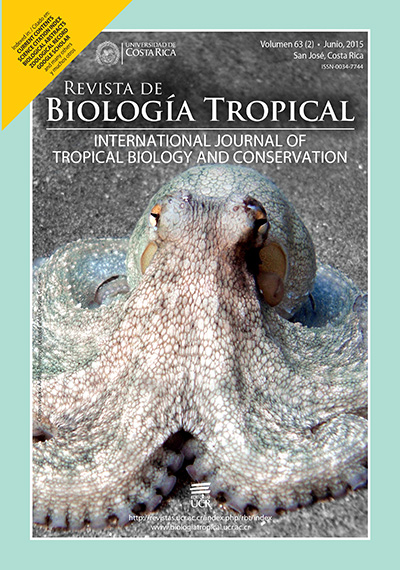Abstract
The genus Lepidochitona (Gray 1821) contains relatively small chitons with a distinctive girdle, dorsally clothed with non-overlapping calcareous corpuscles. In the Caribbean, it is represented by four species: L. liozonis (Dall, & Simpson, 1901), L. rosea Kaas, 1972, L. rufoi García-Ríos, 2010 and L. bullocki García-Ríos, 2011. A rutinary morphological inspection of 10 specimens of a Lepidochitona species from the Florida Keys was concordant with L. liozonis (the only species of the genus informed for Florida). They did not show many morphological differences that could justify its separation from the specimens from Puerto Rico (the type locality). However, the comparison of sequences of the mitochondrial gene coding for cytochrome oxidase I (COI) of L. liozonis from Puerto Rico and the Florida specimens showed a divergence of 14%. This divergence is incompatible with a reproductively connected species. In addition to their genetic differences, the new species differs from L. liozonis in having bigger size, longer marginal spicules and a postmucronal slope very concave.
References
International Code of Zoological Nomenclature. (1999). International code of zoological nomenclature (4th ed.). London: ICZN.
Folmer, O., Black, M., Hoeh, W., Lutz, R., & Vrijenhoek R. (1994). DNA primers for amplification of mitochondrial cytochrome c oxidase subunit I from diverse metazoan invertebrates. Molecular Marine Biology and Biotechnology, 3, 294-299.
García Ríos, C. (2003). Los quitones de Puerto Rico. San Juan, P.R.: Isla Negra.
García-Ríos, C. I. (2006). A New species of Lepidochitona (Mollusca: Polyplacophora) from El Salvador. Veliger, 48, 206-214.
García-Ríos, C. I., Pérez-Pérez, N. M., Fernández-López, J., & Fuentes, F. A. (2014). Calibrating the chitons (Mollusca: Polyplacophora) molecular clock with the mitochondrial DNA cytochrome C oxidase I gene. Revista de Biología Marina y Oceanografía, 49, 193-207. Recuperado de http://www.redalyc.org/articulo.oa?id=47931776003> ISSN 0717-3326
Hall, T. A. (1999). BioEdit: a user-friendly biological sequence alignment editor and analysis program for Windows 95/98/NT. Nucleic Acids Symposium Series, 41, 95-98.
Kaas, P. (1972). Polyplacophora of the Caribbean Region. The Hague: Martinus Nijhoff.
Kaas, P., & Belle, R. (1985). Monograph of living Chitons: (Mollusca: Polyplacophora) [Monograph]. doi: ISBN-10: 9789004074149.
Kaas, P., & Belle, R. (1998). Catalogue of living chitons (Mollusca, Polyplacophora. Leiden, the Netherlands: Backhuys.
Kelly, R. P., Sarkar, I. N., Eernisse, D. J., & Desalle, R. (2007). DNA bar-coding using chitons (genus Mopalia). Molecular Ecology Notes, 7, 177-183.
Knowlton, N. (2000). Molecular genetic analyses of species boundaries in the sea. Hydrobiologia, 420, 73-90.
Littler, D., & Littler, M. (2000). Caribbean reef plants. Washington, D.C.: OffShore Graphics.
Pilsbry, H. A. (1940). Nautilus 53(3), pl 12, f 4.
Redfern, C. (2013). Bahamian seashells: 1161 species from Abaco, Bahamas. Boca Raton, Florida: Bahamian Seashells.
Saitou, N., & Nei, M. (1987). The neighbor-joining method: A new method for reconstructing phylogenetic trees. Molecular Biology and Evolution, 4, 406-425.
Tamura, K., Dudley, J., Nei, M., & Kumar, S. (2007). MEGA4: molecular evolutionary genetics analysis (MEGA) software version 4.0. Molecular Biology and Evolution, 24, 1596-1599.
Thompson, J. G., Higgins, D. G., & Gibson, T. J. (1994). CLUSTAL W: improving the sensitivity of progressive multiple sequence alignment through sequence weighting, position-specific gap penalties and weight matrix choice. Nucleic Acids Research, 22, 4473-4680.
Ward, R. D. (2009). DNA barcode divergence among species and genera of birds and fishes. Molecular Ecology Resources, 9, 1077-1085.
##plugins.facebook.comentarios##

This work is licensed under a Creative Commons Attribution 4.0 International License.
Copyright (c) 2015 Revista de Biología Tropical


